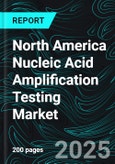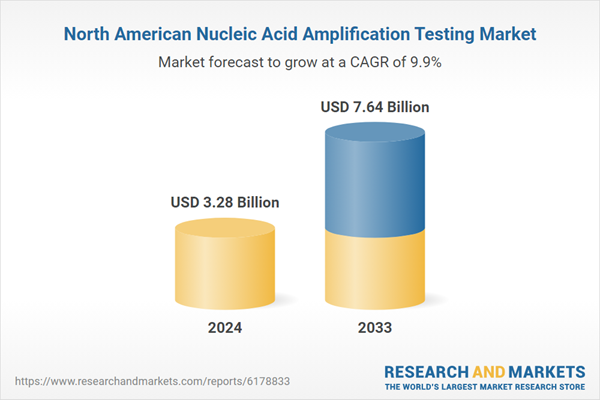North America Nucleic Acid Amplification Testing Industry Overview
The North America nucleic acid amplification testing (NAAT) industry is witnessing consistent expansion, driven by rising healthcare awareness and the growing need for accurate, rapid molecular diagnostics. NAAT plays a crucial role in identifying infectious diseases, genetic mutations, and oncology biomarkers. Its ability to detect pathogens with high sensitivity and specificity has positioned it as a preferred diagnostic tool across hospitals, laboratories, and research institutions. The region’s strong healthcare infrastructure and widespread availability of advanced testing systems have accelerated adoption. Furthermore, ongoing investments in biotechnology and molecular diagnostics continue to foster innovation, expanding NAAT’s scope across medical, forensic, and veterinary applications.Technological progress has significantly enhanced NAAT’s efficiency, reliability, and versatility. The introduction of automated platforms, multiplex assays, and portable testing solutions is transforming laboratory workflows and point-of-care diagnostics. The integration of NAAT in personalized medicine and precision oncology further underscores its clinical importance. Governments and private organizations across North America are supporting diagnostic modernization through funding initiatives and regulatory approvals. Additionally, rising awareness of early disease detection and outbreak surveillance has reinforced NAAT’s relevance in healthcare strategies. The growing use of real-time PCR and isothermal amplification methods is enhancing throughput while maintaining diagnostic accuracy across a wide range of conditions.
Looking ahead, the North America NAAT market is expected to expand through advancements in assay design, automation, and data integration. However, high testing costs, stringent regulatory frameworks, and supply chain complexities remain key challenges. Efforts to improve affordability, accessibility, and turnaround time are driving collaborations between technology developers, diagnostic laboratories, and healthcare providers. As precision diagnostics and molecular testing continue to shape modern healthcare, NAAT will remain central to clinical decision-making and disease control across the North American region.
Key Factors Driving the North America Nucleic Acid Amplification Testing Market Growth
Rising Demand for Accurate and Rapid Diagnostics
The growing need for precise and rapid diagnostic solutions is a key factor driving the North America NAAT market. With increasing incidences of infectious diseases, genetic disorders, and oncology cases, healthcare providers rely on molecular techniques for early and accurate detection. NAAT offers superior sensitivity compared to conventional methods, enabling identification of low pathogen loads and asymptomatic carriers. Its rapid turnaround time enhances clinical decision-making and infection control. The growing emphasis on preventive care and personalized medicine has further boosted test utilization across hospitals and laboratories. Moreover, the adoption of point-of-care NAAT devices supports decentralized testing, improving access in remote or high-demand settings. As diagnostic accuracy becomes critical for patient management and public health surveillance, NAAT continues to gain traction as a gold-standard testing solution across North America’s healthcare landscape.Technological Advancements and Automation
Technological innovation and automation are significantly propelling growth in the North America NAAT market. The development of fully automated systems has streamlined workflows, minimized manual errors, and enhanced throughput for high-volume laboratories. Integration of multiplexing capabilities allows simultaneous detection of multiple pathogens, improving testing efficiency and cost-effectiveness. Real-time PCR, digital PCR, and isothermal amplification technologies have expanded the range of diagnostic applications. Additionally, advancements in reagents, software integration, and cloud-based result management are enhancing accuracy and traceability. Portable and user-friendly devices are also driving adoption in decentralized and field-testing environments. The emphasis on miniaturization and connectivity supports real-time data sharing and surveillance. Continuous innovation, supported by strong R&D investments and regulatory approvals, ensures that automation remains a key enabler of speed, scalability, and reliability in the evolving North American NAAT market.Increased Focus on Public Health and Disease Surveillance
Growing public health initiatives and the emphasis on early detection are major growth drivers for the North America NAAT market. Governments and health agencies are increasingly deploying molecular diagnostics for outbreak monitoring, pandemic preparedness, and routine surveillance. NAAT’s accuracy in detecting emerging and re-emerging pathogens has made it indispensable in managing infectious disease threats. Collaborations between public institutions and private diagnostic companies are strengthening testing capacity and infrastructure. Furthermore, screening programs for sexually transmitted infections, respiratory illnesses, and genetic conditions are expanding across regional healthcare systems. NAAT’s adaptability to high-throughput platforms supports mass testing and real-time reporting, crucial for epidemic control. With policy-level focus on precision healthcare and early intervention, the integration of NAAT into public health frameworks continues to grow. This sustained emphasis on proactive diagnostics ensures long-term market stability and advancement.Challenges in the North America Nucleic Acid Amplification Testing Market
High Cost of Testing and Equipment
The high cost associated with NAAT remains a major constraint in market expansion across North America. Advanced molecular testing platforms require substantial capital investment, limiting accessibility for smaller laboratories and rural healthcare facilities. The expense of specialized reagents, consumables, and quality control materials adds to overall operational costs. Furthermore, skilled personnel are required to manage and interpret complex assays, increasing training expenditures. Reimbursement limitations and variability among payers further hinder widespread adoption. Although technological advancements are improving cost-efficiency, price sensitivity continues to influence decision-making in resource-constrained environments. Efforts to develop low-cost assays and portable testing solutions are underway, yet scalability remains a challenge. Addressing affordability while maintaining accuracy and reliability will be essential for ensuring equitable access and broader utilization of nucleic acid amplification testing across North America.Regulatory Complexity and Standardization Issues
Stringent regulatory frameworks and the lack of standardized testing protocols pose challenges for the North America NAAT market. Diagnostic manufacturers must navigate extensive approval processes from agencies such as the FDA and Health Canada, which can delay product launches and increase compliance costs. Differences in regulatory requirements across countries and states add to operational complexity. Additionally, variability in assay performance and interpretation can affect result consistency, particularly in decentralized or point-of-care settings. Standardization efforts are ongoing but require alignment between regulators, laboratories, and industry stakeholders. Ensuring data reliability, quality assurance, and interoperability across platforms remains a critical concern. Addressing these issues through harmonized guidelines and validation frameworks is essential to enhance market transparency and foster trust among end-users. Streamlined regulatory pathways will be key to supporting innovation and accelerating adoption in the region.North America Nucleic Acid Amplification Testing Market Overview by Regions
The North American market demonstrates robust growth, led by the United States’ advanced healthcare infrastructure and Canada’s expanding diagnostic ecosystem, with both countries investing heavily in molecular testing innovation and disease surveillance programs. The following provides a market overview by region:United States Nucleic Acid Amplification Testing Market
The United States represents the largest share of the North America NAAT market, driven by its advanced healthcare system, strong research capabilities, and extensive clinical laboratory network. Widespread adoption of molecular diagnostics across infectious disease, oncology, and genetic testing applications underscores the nation’s focus on precision medicine. Government funding and private-sector partnerships are strengthening public health infrastructure and outbreak response capacity. The presence of leading diagnostic manufacturers and biotechnology firms accelerates technological advancement and market competitiveness. High awareness among healthcare providers and patients supports continuous testing demand. Although cost and regulatory challenges persist, initiatives promoting automation, accessibility, and digital integration are improving operational efficiency. The U.S. continues to lead in test development and deployment, making it a cornerstone of molecular diagnostics innovation within the North American region.Canada Nucleic Acid Amplification Testing Market
Canada’s NAAT market is expanding steadily, supported by investments in healthcare modernization, research, and public health initiatives. The growing adoption of molecular diagnostics in infectious disease surveillance and genetic screening enhances national diagnostic capabilities. Provincial healthcare systems are increasingly integrating NAAT into clinical workflows, emphasizing early detection and preventive care. Collaborations between academic institutions, research centers, and diagnostic companies are fostering innovation and technology transfer. Government support for laboratory expansion and disease control programs further strengthens market foundations. However, regional disparities in access and cost considerations remain key challenges. Efforts to improve affordability and training are addressing these gaps. As awareness and infrastructure advance, Canada’s market is positioned for sustained growth, contributing significantly to North America’s overall molecular diagnostics landscape through its focus on quality, accessibility, and public health outcomes.Market Segmentations
Type
- Polymerase Chain Reaction (PCR) Tests
- Isothermal Nucleic Acid Amplification Technology (INAAT) Tests
- Ligase Chain Reaction (LCR) Tests
Application
- Infectious Disease Testing
- Oncology Testing
- Others
End Use
- Central & Reference Laboratories
- Hospitals
- Others
Country
- United States
- Canada
All the Key players have been covered
- Overviews
- Key Persons
- Recent Developments
- SWOT Analysis
- Revenue Analysis
Company Analysis:
- F. Hoffmann-La Roche Ltd
- Becton, Dickinson and Company
- Danaher Corporation
- Abbott Laboratories
- Illumina, Inc.
- Siemens Healthineers
- bioMérieux SA
- Novartis AG
- Bio-Rad Laboratories, Inc.
- Seegene Inc.
Table of Contents
Companies Mentioned
- F. Hoffmann-La Roche Ltd
- Becton, Dickinson and Company
- Danaher Corporation
- Abbott Laboratories
- Illumina, Inc.
- Siemens Healthineers
- bioMérieux SA
- Novartis AG
- Bio-Rad Laboratories, Inc.
- Seegene Inc.
Methodology
In this report, for analyzing the future trends for the studied market during the forecast period, the publisher has incorporated rigorous statistical and econometric methods, further scrutinized by secondary, primary sources and by in-house experts, supported through their extensive data intelligence repository. The market is studied holistically from both demand and supply-side perspectives. This is carried out to analyze both end-user and producer behavior patterns, in the review period, which affects price, demand and consumption trends. As the study demands to analyze the long-term nature of the market, the identification of factors influencing the market is based on the fundamentality of the study market.
Through secondary and primary researches, which largely include interviews with industry participants, reliable statistics, and regional intelligence, are identified and are transformed to quantitative data through data extraction, and further applied for inferential purposes. The publisher's in-house industry experts play an instrumental role in designing analytic tools and models, tailored to the requirements of a particular industry segment. These analytical tools and models sanitize the data & statistics and enhance the accuracy of their recommendations and advice.
Primary Research
The primary purpose of this phase is to extract qualitative information regarding the market from the key industry leaders. The primary research efforts include reaching out to participants through mail, tele-conversations, referrals, professional networks, and face-to-face interactions. The publisher also established professional corporate relations with various companies that allow us greater flexibility for reaching out to industry participants and commentators for interviews and discussions, fulfilling the following functions:
- Validates and improves the data quality and strengthens research proceeds
- Further develop the analyst team’s market understanding and expertise
- Supplies authentic information about market size, share, growth, and forecast
The researcher's primary research interview and discussion panels are typically composed of the most experienced industry members. These participants include, however, are not limited to:
- Chief executives and VPs of leading corporations specific to the industry
- Product and sales managers or country heads; channel partners and top level distributors; banking, investment, and valuation experts
- Key opinion leaders (KOLs)
Secondary Research
The publisher refers to a broad array of industry sources for their secondary research, which typically includes, however, is not limited to:
- Company SEC filings, annual reports, company websites, broker & financial reports, and investor presentations for competitive scenario and shape of the industry
- Patent and regulatory databases for understanding of technical & legal developments
- Scientific and technical writings for product information and related preemptions
- Regional government and statistical databases for macro analysis
- Authentic new articles, webcasts, and other related releases for market evaluation
- Internal and external proprietary databases, key market indicators, and relevant press releases for market estimates and forecasts

LOADING...
Table Information
| Report Attribute | Details |
|---|---|
| No. of Pages | 200 |
| Published | September 2025 |
| Forecast Period | 2024 - 2033 |
| Estimated Market Value ( USD | $ 3.28 Billion |
| Forecasted Market Value ( USD | $ 7.64 Billion |
| Compound Annual Growth Rate | 9.8% |
| Regions Covered | North America |
| No. of Companies Mentioned | 10 |









